Text
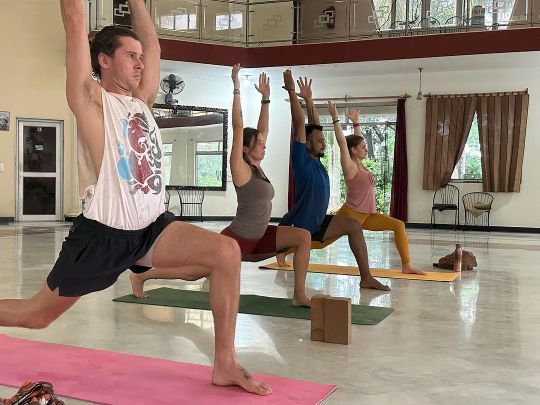
It’s time to roll out your yoga mat and discover the combination of physical and mental exercises that for thousands of years have hooked yoga practitioners around the globe. The beauty of yoga is that you don’t have to be a yogi or yogini to reap the benefits. Whether you are young or old, overweight or fit, yoga has the power to calm the mind and strengthen the body. Don’t be intimidated by yoga terminology, fancy yoga studios and complicated poses. Yoga is for everyone.
Start with basic postures.
If you’re just starting out, choose simple beginner asanas like Mountain, Cat and Cow, Seated Head to Knee, Downward-Facing Dog, Cobra, Triangle, Crescent Lunge, Reclining Goddess, and Bridge.
#morningyoga#yoga#yogapractice#yogainspiration#yogalife#yogaeverydamnday#yogateacher#yogaeveryday#yogagirl
7 notes
·
View notes
Text
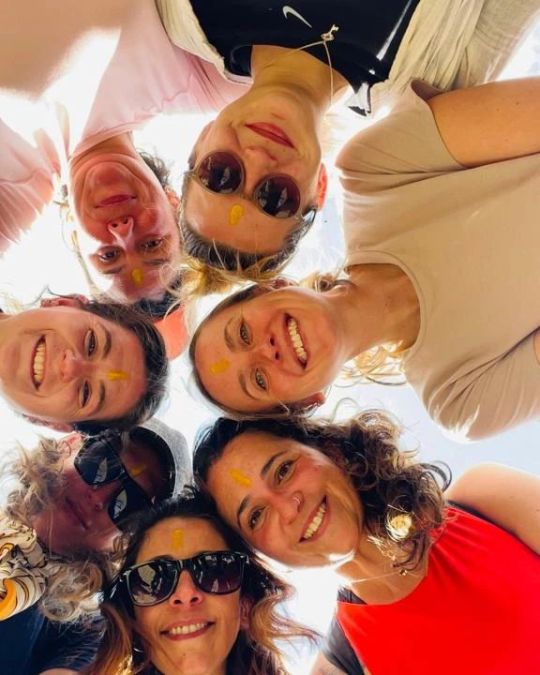
Wishing you a blissful International Yoga Day filled with serenity, strength, and self-discovery. Namaste! On this International Yoga Day, may you find solace in the practice of yoga and experience the profound benefits it brings. Stay healthy and happy!
1 note
·
View note
Text
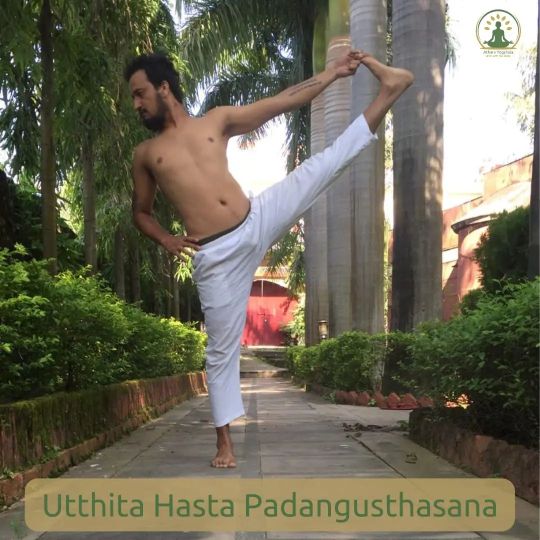
Utthita Hasta Padgangusthasa (Extended Hand to Big Toe Pose) is about staying connected to the foundation of ease and equanimity that is always within us while we work with the deep strength of our core, the flexibility of our periphery, and the openness of our hearts.
#utthita#yoga#asana#hasta#yogaeverywhere#trikonasana#yogachallenge#yogalife#padangusthasana#alostrongandflexy
3 notes
·
View notes
Text

"Yoga is the fountain of youth. You’re only as young as your spine is flexible.
#yoga#fitness#meditation#yogapractice#yogainspiration#love#yogalife#yogaeeverydamnday#yogi#mindfulnes#yogateacher#yogalove#workout#gynm#yogaeveryday
6 notes
·
View notes
Text

Vajrasana pose is a simple sitting yoga pose. Its name comes from the Sanskrit word vajra, which means thunderbolt or diamond.
For this pose, you kneel and then sit back on your legs to take the weight off your knees. Breathing and meditative exercises are often done in this position, which is said to help your body become as strong as a diamond.
#vajrasana#yoga#yogposes#yogainspiration#yogapractice#asana#yogaeveryday#yogalove#yogalife#atharvyogshala
2 notes
·
View notes
Text

Visvamitrasana is the pose named after a king-turned-sage Visvamitra. The meaning of Vishwamitra is; Visva means ‘the world’, Mitra means ‘a friend’. Sage Visvamitra is known for his yogic power of compassion towards all the people he used to meet. This pose gives an opening to the heart i.e. compassion center in our body, so Visvamitrasana is dedicated to sage Vishwamitra.
This asana not just provides strength and vigor, which utilizes the prana to nourish the life but also helps in establishing a balance within. So, the practitioner is able to tune in with their surroundings and react in a friendly manner to keep humanity alive for the ages.
#visvamitrasana#yoga#yogapractice#yogainspiration#yogachallenge#yogapose#yogateacher#yogagirl#armbalance#igyoga#yogaeverywhere
4 notes
·
View notes
Text

Chakrasana is a strong back-bending yoga asana. It is popular in many forms of yoga and is part of the primary series of Ashtanga yoga. As well as being a back bend, chakrasana is seen in yoga as a heart opening posture and is thought to work on the heart chakra.
#chakrasana#yoga#chakras#wheelpose#yogapractice#chakrahealing#meditation#backbend#chakrameditation#chakrabalancing#chakrastones#chakrabalance#yogainspiration#chakracleansing#yogattcinrishikesh#yogainindia#atharvyogshala
5 notes
·
View notes
Text
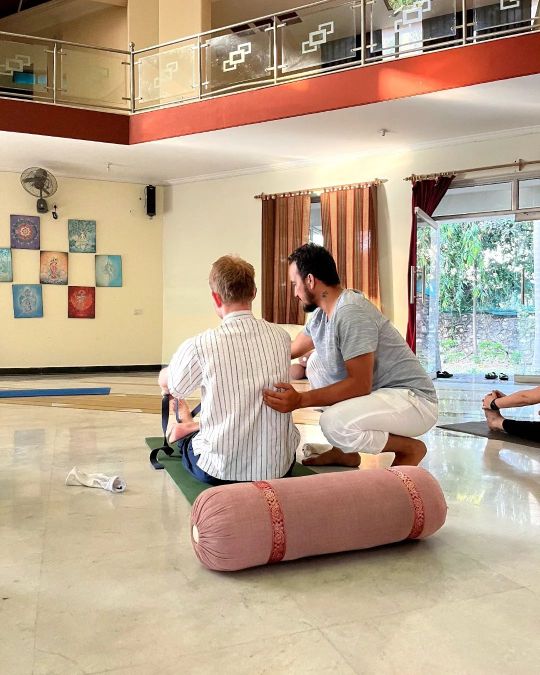
Our own self-realization is the greatest service we can render the world.
Ramana Maharshi
#selfrealization#realization#realizations#derealization#fellowship#movierealization#godrealization#realizationacademy#hollowrealization#atharvyogshala
4 notes
·
View notes
Text

"Learning to be present with yourself and to abide in that which is steady and comfortable does not allow space for self-judgment. When you live this way, you are practicing yoga: you are living fully."
Our monthly programs
Visit
www.atharvyogshala.com
🙏🏻🧘🏻♂️
#yoga#health#india#bhfyptraining#fitnessmotivation#sport#yog#selflove#crossfit#peace#healthylifestyle#selfcare#wellness#meditation#energy#mindfulness#healing#spiritual#balance#namaste
8 notes
·
View notes
Text

Impressed by Ganesha, Lord Shiva gave him the privilege of being worshipped first. Resultant, Lord Kartikeya showed his anger on the decision and sacrificed his body and bones to his father as reverence. It is believed that this whole incident took place here, and thus, the temple is named as Kartik Swami.
To explore mystical temples in Himalayas ,join us on our upcoming Himalayan pilgrims rertreat.
1 note
·
View note
Text

Yoga is a great practice for both the body and the mind, it offers peace and mindfulness to its practitioners and helps them get through daily stress.
🙏🏻🧘🏼♀️☀️
6 notes
·
View notes
Text

We are glad and honored to have the people around the world to complete Himalayan hiking yoga retreat which was not as easy as we are predicting in beginning.
We are happy all the participants accept the challenges of weather ,lack of resources in mountains and keep positive approach to experience divinity of Himalayas mystical temples.
May all of you have good fortune and peace of life.
Namaste 🙏
Atharvyogshala
3 notes
·
View notes
Text
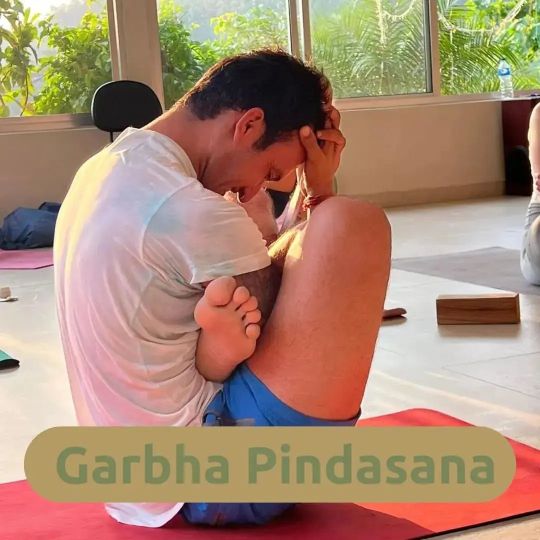
GARBHA PINDASANA
There are a few anatomical actions that we need to be concerned with in garbha pindasana and kukkutasana. We continue to explore the depth of our lotus because both of the poses require a deep external hip rotation and flexion of the hip joint. If we are doing the full expression of garbha pindasana, then we are also sliding our arms through the openings between the legs in our lotus and folding the legs into our chest. Folding the lotus towards the chest happens by flexing at the hip joints.
The rolling action in garbha pindasana also requires a sufficient amount of spinal flexion. As I often say, round things roll, and flat things flop. If you don’t or can’t sufficiently flex the hips and tuck your head in, your spine doesn’t round enough to roll on it. There are some other considerations below as well.
In kukkutasana, we undo that flexion enough to place our hands on the floor and press up to lift our body off the floor. Here we are required, once again, to access the armpits for pushing into the floor. This requires strength and stability of the shoulder girdle.
#asana#yoga#yogapractice#yogainspiration#yogalife#yogaeveryday#yogateacher#yogalove#yogapose#yogaeverydamnday#yogi#yogaeverywhere#namaste#yogachallenge#meditation#yogagirl#yogini#yogajourney#hathayoga#instayoga#igyoga#yogaposes#yogadaily#fitness
8 notes
·
View notes
Text

As in warrior I, the action of flexion in the front hip and knee is eccentric in relationship to the pull of gravity. Unlike warrior I, however, the abductors of the front leg are working concentrically to abduct the hip—because the foot is on the ground, this action is proximal and has the effect of rotating the pelvis open to the side. In the back leg, simultaneous hip extension and abduction are challenging—the articulation of the pelvis and sacrum at the SI joint can take some of the pressure of these actions away from the ligaments and capsule of the hip joint.
Like warrior I, a wide variety of opinions exists about how much external rotation is needed in the back hip joint. The amount of rotation depends on a variety of factors and should arise from the action of the foot and whole leg, rather than being an isolated hip joint action. The more mobility there is in the SI joint and hip joint of the front leg, the less spinal rotation is needed to turn the chest to face the side.
If the chest is not clearly facing sideways, the spreading of the arms can put pressure on the brachial plexus (the web of nerves that extend into the arm), which travels from the side of the cervical spine under the clavicle and under the pectoralis minor. Keeping the arms in line with the sides of the torso helps to prevent this compression, which can result in sensations of numbness or tingling in the arms.
#warrior#yoga#virbhadrasana#yogapractice#yogainspiration#yogateacher#yogaposes#warriorpose#yogaeverywhere#yogaeveryday#yogaverydamnday]#yogapose#yogalife#yogi#yogachallenge#yogalove#reversewarrior#yogagirl
2 notes
·
View notes
Text
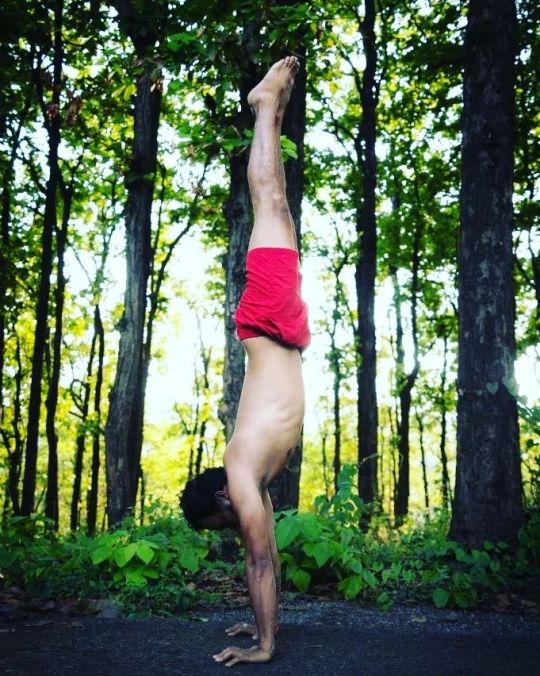
Adho Mukha Vrksasana is a variant of the Vrksasana, in effect an inverted version of the tree pose. It is described by another name in at least one major yoga text, and is a challenging yoga asana for beginners, owing to its demands on the practitioner's sense of balance.
Meaning of Adho Mukha Vrksasana
Vrksasana is a tree pose in which one stands with the hand raised towards the sky. Adho Mukha Vrksasana can be termed as a tilted tree pose wherein one hand is supporting the entire body weight. It is hence a handstand pose. This asana when done by beginners has to be done very carefully as balancing oneself on one hand is challenging.
#handstand#calisthenics#yoga#gymnastics#fitness#workout#streamworkout#handstandpractice#flexibility#gym#balance#training#motivation#handstands#acrobatics#circus
4 notes
·
View notes
Text
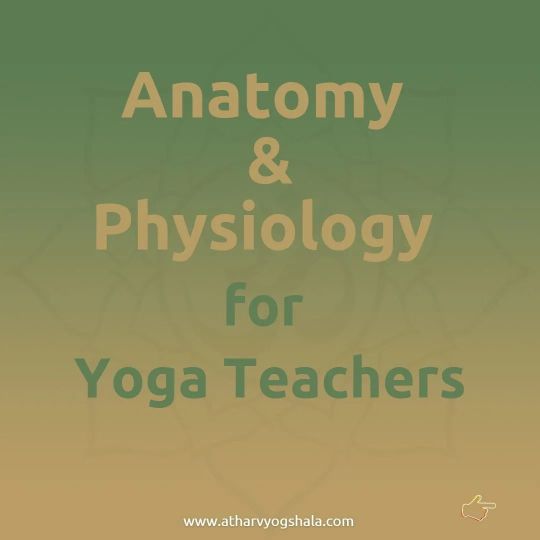
Yoga is one of the most popular forms of exercise that has a great impact on our physical and mental health.
To understand its impact, it is important to know the inner structure and functioning of the body.
As a yoga teacher or practitioner, you must be familiar with the limitations of each body type and its level of experience.
Therefore teachers must learn about the basics of anatomy and physiology to understand what’s going on in the body and achieve the full benefits of yoga.
What is Yoga Anatomy?
Anatomy is a medical term and it deals with the study of basic structures of the body. Its teaching includes the study of bones, muscles, joints, and other internal organs of the body.
All Yoga teachers need to understand the structure of the human body to increase the effectiveness of asanas and protect the body from injuries.
With this anatomical awareness you will be prepared to deal with injuries in an effective, yet protected manner.
What is Yoga Physiology?
Yoga Physiology is the science that deals with the functioning of the body parts and their specific roles.
Its teaching includes the study of the function of different organs like respiration, reproduction, digestion, osmoregulation, and a lot more.
It is a dynamic study that reveals how different systems in the body function collectively as a single unit that is moved by energy.
Anatomy vs Physiology
The word ‘anatomy’ refers to the ‘structure of body’, while ‘physiology’ refers to ‘function of the body’.
In the anatomy of yoga, you will learn about the detailed structure of different parts and organs of the body.
Whereas in yoga physiology you will be studying the functions of these body parts and organs in a coordinated way.
These two terms are often studied jointly and are incomplete without each other. One needs to know anatomy before acquiring the knowledge of physiology, conversely, only studying anatomy without understanding physiology is simply worthless.
#anatomyofyoga#anatomy#yoga#yogateacher#yogapractice#anatomyandphysiology#yogajourney#anatomystudy#anatomynerd#anatomypractice#yogaanatomy#yogainspiration#anatomyforyogis#anatomyinmotion#anatomyartwork
2 notes
·
View notes
Text

What is Paschimottanasana?
Paschimottanasana happens to be a classic yoga pose which means ‘Seated Forward Bend’ pose in English. This pose involves the practitioners folding the top half of their body over their seated lower half. In order to successfully practise this pose, practitioners are required to be mentally focused and flexible. When practising this pose, your entire body is stretched, including your calves, hamstrings, and your spine. In this article, let’s find out the types of Paschimottanasana, the steps and some precautions to consider while performing this yoga pose!
Types of Paschimottanasana
You can incorporate the following variations when you attempt to practise Paschimottanasana such that you don’t strain your muscles:
Paschimottanasana with a Prop
In case you find it hard to place your legs on the floor without bending your knees, you can use a prop to support your knees and place it below them. This prop could be a blanket or a flat pillow. If you feel any strain on your chest or lower abdomen, you can place this prop on your thighs such that when you stretch forward, you can breathe with greater ease.
Paschimottanasana with a Strap
In order to thoroughly stretch your body in this pose, you are required to hold your toes. If you aren’t able to do this, you can use a strap around your feet and hold onto it. This strap will provide you with additional support and will help you execute the Paschimottanasana yoga pose better.
Paschimottanasana with Bent Knees
In the event you find it hard to focus on your breath as your hamstrings feel tight, you could perform this pose with bent knees. Furthermore, you could sit on a pillow which will lift up your hips and allow you to reach your toes.
#paschimottanasana#yoga#yogapractice#yogainspiration#forwardfold#yogaeverydamnday#yogateacher#yogaeveryday#yogaeverywhere#asana#yogagirl#yogachallenge#yogalove#yogalife#yogapose#yogi#seatedforwardfold#yogaposes#yogajourney#seatedforward#yogini#halasana#forwardbend#yogaathome#ashtangayoga
7 notes
·
View notes